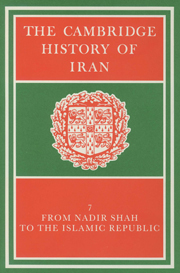Book contents
- Frontmatter
- PART 1 THE POLITICAL FRAMEWORK, 1722–1979
- PART 2 FOREIGN RELATIONS
- PART 3 ECONOMIC AND SOCIAL DEVELOPMENTS
- 13 LAND TENURE AND REVENUE ADMINISTRATION IN THE NINETEENTH CENTURY
- 14 THE TRIBES IN EIGHTEENTH- AND NINETEENTH-CENTURY IRAN
- 15 THE TRADITIONAL IRANIAN CITY IN THE QāJāR PERIOD
- 16 EUROPEAN ECONOMIC PENETRATION, 1872–1921
- 17 ECONOMIC EVELOPMENT, 1921–1979
- 18 THE IRANIAN OIL INDUSTRY
- PART 4 RELIGIOUS AND CULTURAL LIFE, 1721–1979
- Genealogical tables
- Bibliographies
- Index
- References
15 - THE TRADITIONAL IRANIAN CITY IN THE QāJāR PERIOD
from PART 3 - ECONOMIC AND SOCIAL DEVELOPMENTS
Published online by Cambridge University Press: 28 March 2008
- Frontmatter
- PART 1 THE POLITICAL FRAMEWORK, 1722–1979
- PART 2 FOREIGN RELATIONS
- PART 3 ECONOMIC AND SOCIAL DEVELOPMENTS
- 13 LAND TENURE AND REVENUE ADMINISTRATION IN THE NINETEENTH CENTURY
- 14 THE TRIBES IN EIGHTEENTH- AND NINETEENTH-CENTURY IRAN
- 15 THE TRADITIONAL IRANIAN CITY IN THE QāJāR PERIOD
- 16 EUROPEAN ECONOMIC PENETRATION, 1872–1921
- 17 ECONOMIC EVELOPMENT, 1921–1979
- 18 THE IRANIAN OIL INDUSTRY
- PART 4 RELIGIOUS AND CULTURAL LIFE, 1721–1979
- Genealogical tables
- Bibliographies
- Index
- References
Summary
The heading for this chapter is deliberately imprecise. It refers to urban life in the period immediately preceding that when the many changes occurred which thrust Iran into the 20th century: large-scale importation of European goods; the development of an export market for some indigenous commodities; the increasing effect upon the economy of foreign banks and currencies; and, at a humbler level, the appearance of the kerosene lamp and cooking-stove, the sewing-machine and, later, the typewriter, the bicycle and radio. There are no dates to mark the passing of the traditional Iranian city, but what this chapter endeavours to present is a portrait, along the lines of Peter Laslett's enquiry into the social conditions of pre-industrial England, of the world that the Iranians lost in that transition. Such an undertaking is fraught with problems of description, analysis and interpretation. The documentation which served as the starting-point for the researches into medieval and early modern France of the Annales School, so influential in the development of the “new” social history, is almost wholly lacking for 19th century Iran. Statistical data is scarce. Surviving records, personal memoirs and correspondence from Qājār times, while attracting increased attention from historians, have survived haphazardly. The researcher remains dangerously dependent upon the subjective accounts of European diplomats, travellers and missionaries. Thus the chapter which follows, focusing mainly upon the reigns of Āghā Muhammad Khān, Fath ‘Alī Shāh and, to a lesser extent, Muhammad Shāh, is based upon an amorphous body of random facts and personal observations.
- Type
- Chapter
- Information
- The Cambridge History of Iran , pp. 542 - 589Publisher: Cambridge University PressPrint publication year: 1991
References
- 1
- Cited by

